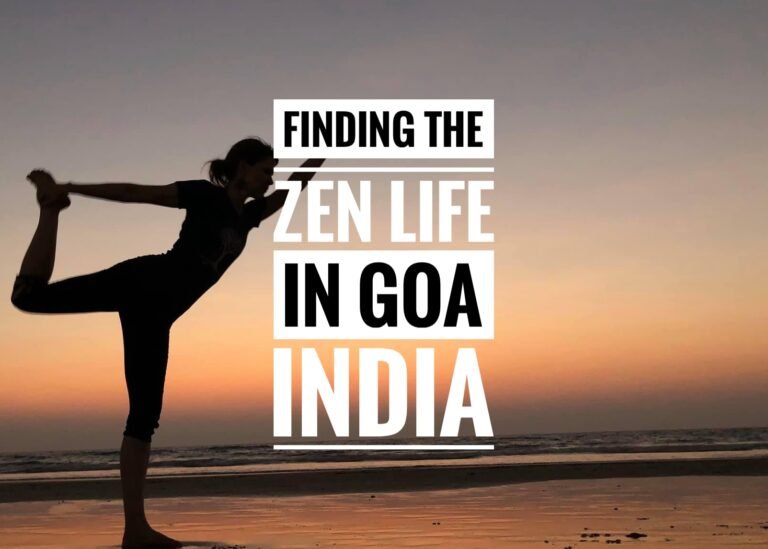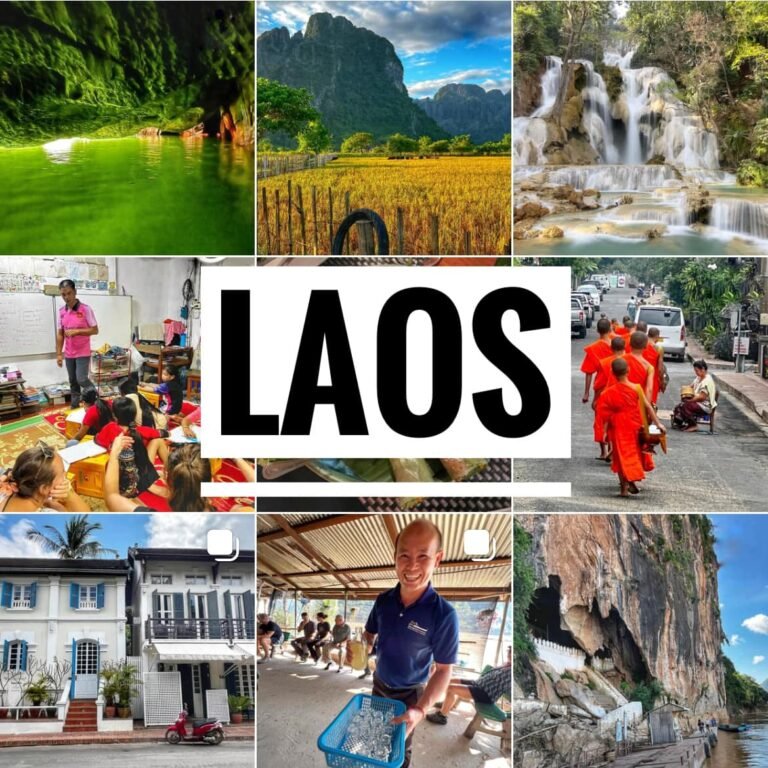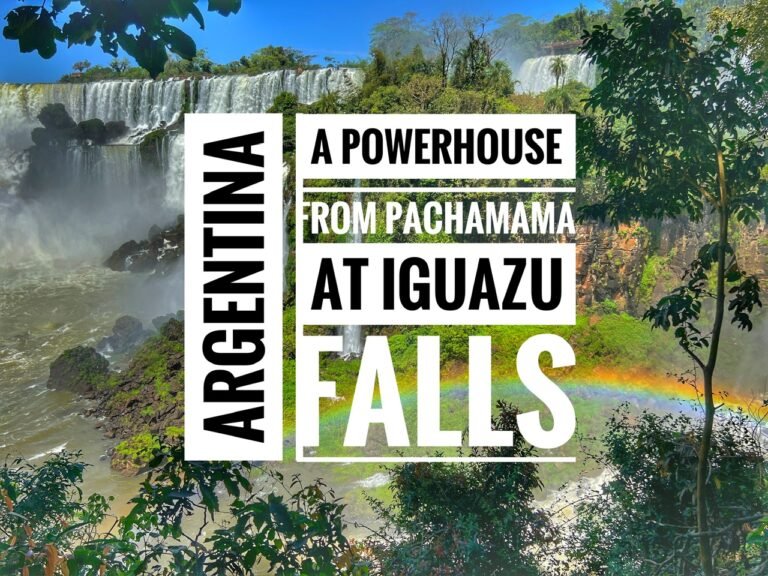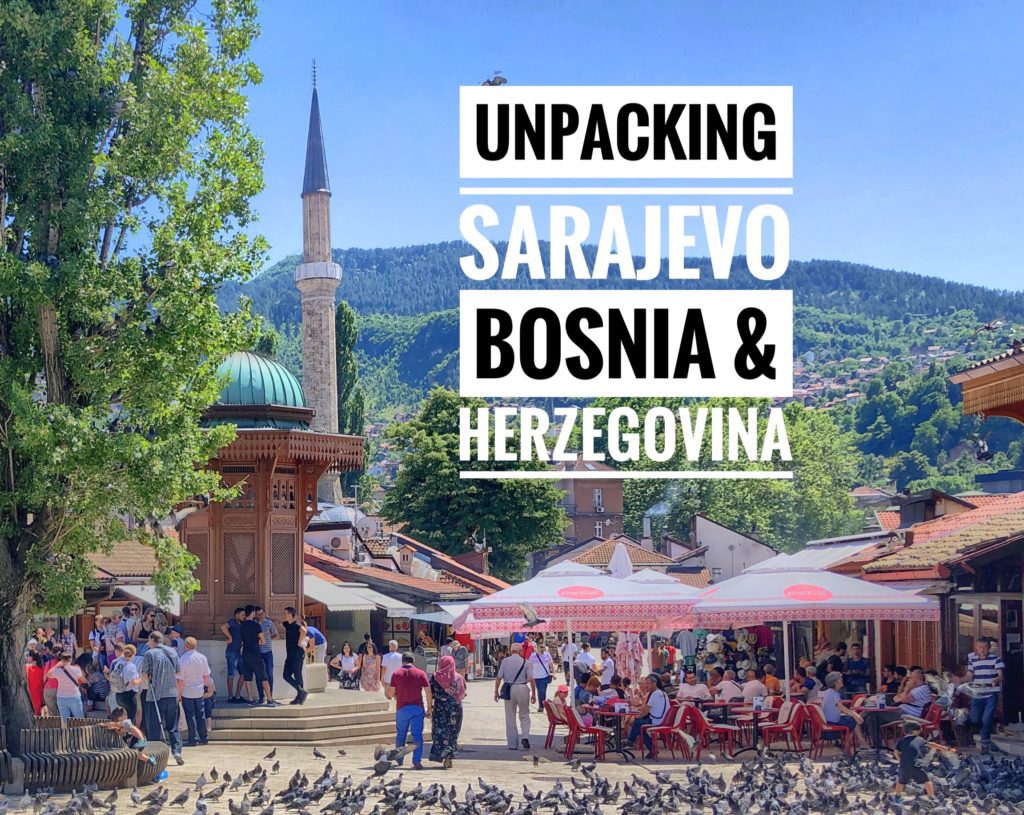
Before we arrived, a few things came to mind when we thought of Sarajevo, etched in our brains from early history lessons and events. Mostly, involving war…the one during the Clinton years, a siege we knew pretty much nothing about, and the beginning of World War I kicking off thanks to the assassination of Archduke Francis Ferdinand. (An obligatory turning point of history we do actually learn in American high schools.)
Thankfully, these images and challenges have been left behind with the 20th century. Today, Sarajevo is bright and cheery, plopped in an idyllic mountain setting with a unique cultural heritage and buzzy vibe. Like the rest of Bosnia & Herzegovina we saw, we loved it and wished we had more time there.

It started with an obnoxiously early 5:30 train ride from Mostar. Was this form of torture our only choice? No, there are multiple buses that run between the two tourist hotspots in Bosnia, but having done nothing but buses in the Balkans, we were eager to hop on the train again. Plus it was significantly cheaper (~$6.50/ticket), not to mention this leg room! The lack of trains, and availability, in the Balkans is definitely a bummer (with the exception of Bulgaria.)

We were thrilled with our huge apartment in Sarajevo ($24/night.) It was the best kind of Airbnb, one where someone actually lives in it, so it is well stocked with kitchen supplies and spices, a stockpile of provided snacks, and was very well decorated, bright, and functional. Most of the time we score these situations is when the hosts go stay with their significant others and just rent out their room as a side hustle. Brilliant.

Some of the delicious food we had in Bosnia. As mentioned in the last post, it’s undoubtedly made for carnivores…the aromatic scent of grilled meat permeates every corner, making it easy to see why stray dogs endlessly roam with their tongues hanging out.
That said, it can be frustrating for a vegetarian on a budget, because meat is by far the cheapest option. A traditional meat meal on bottom right…Minced meatballs with cheese, “salad” and ajvar sauce, the red pepper delight. Some of the vegetarian options included grilled vegetables and a falafel bowl (Turkish not Bosnian).
Also, we had to try a few sips of the walnut variety of Rajka. Definitely the smoothest we had. This is when we learned it’s probably worth it to throw out a few BAM (hehe…that’d be a Bosnian Mark) for quality Rajka, which tastes far better than the locals’ typical offerings extracted from the plastic soda bottles under their sinks.

We found the juxtaposition between this beautiful, ornate building and the modern and bizarre foot bridge interesting. We don’t remember what this beautiful building actually is other than hosting a knockoff Apple store where we went to try desperately to get our iphone unlocked.
(Side story: we thought it was already unlocked when we bought it and left the States, but apparently T-MOBILE was holding it hostage. Long story… but with a very happy Google Fi ending. Yes, we switched carriers while traveling, and kept our original phone number, and are now paying $20-$30/month, instead of $70 with T-mobile, with 4G international roaming! We highly recommend Google Fi for traveling internationally. Click if you wanna save some cash.)

As in most Balkan towns, we loved the way the Bosnians seemed to take long walks every single night at sunset. No phones. No drinking. Just good old-fashioned foot shuffling and gossiping about Ahmed’s new hairdo.
Visiting the Sarajevsko Brewery, which started in 1864, was as much about learning about the war as it was about beer. During the four-year Siege of Sarajevo from 1992-1995, most people of the city had no water (or electricity) for their homes. To find the water, they had zip, duck and roll, and run through the city to collect it at the brewery, often while dodging fire and bullets. Can you imagine?! Repeating…the siege lasted for FOUR years!
Although the public fountains were still running, a common occurrence was for people to get shot by snipers while standing in line at them. Thus, this brewery became a protected water source for people, because, the brewery was ingeniously built atop and surrounding a permanent natural water mineral spring by the Ottomans over a hundred years before. (This would be an absolute dream location for any brewer… pure fresh water pouring from the ground beneath your brewery!) Because of this water life line the Sarajevsko Brewery ended up saving so many lives… Beer provides.

Inside the brewery’s gorgeous tap room

Saint Anthony Catholic Church…According to our walking tour guide, this church is quite progressive and one of the most welcoming in the city. Every Friday, they invite Muslims, Jews or anyone of any faith in for prayer and fellowship time. Christians and Muslims often use this time to meet up, converse, or mingle under the same roof. If only all churches were this inviting. It’s especially amazing to learn this given their recent turbulent and bloody history.

The Sarajevo City Hall was completely bombed out during the siege. The original structure was built by the Austro-Hungarian Empire in what they thought was a complementary Ottoman-style architecture at the time in order to honor the city’s heritage. However, they hired a Spanish architect who modeled the town hall in a Moorish style rather than anything Ottoman. It’s quite an oddball when you look at the scope of surrounding architecture. At least it’s a pretty and aesthetic oddball.

1992…1993…1994…1995. Nearly every pearl white pillar in this endlessly stretching Bosniak (Muslim) Kovaci Cemetery is stamped with these four years. The number of unmarked tombstones was abundant. It was probably one of the most saddening and stark cemeteries we’ve experienced, it was impossible not to think that the majority probably did not go in peace.

Another cemetery with some similar stark reminders of the recent history.

Entering the Baščaršija, or main bazaar of Sarajevo is like being transported to Turkey or the Middle East only steps away from Europe. It is bustling with energy and life. Vendors offering anything and everything, restaurants overflowing with those carnivorous smells, delectable gelato temptations and groups of friends sharing a hookah pipe. Also, there are lots of people enjoying Rajka and beers. We were told by our guide it’s probably one of the more liberal Muslim places around. Oh, and the pigeons. People wearing pigeons. People feeding pigeons. People stepping on pigeon poo. It’s quite the ensemble.
More Baščaršija scenes.

According to our city guide, this high school has three very famous graduates. Two were Nobel peace prize winners (yay!) and the third, which no one likes to talk about, is the guy who altered the course of history (boo!) We’ll get to that in a minute.
Speaking of school, our guide also told a couple stories about her own life during the siege. At about our age, she would have been around 10-14 years old during the time when bombs were falling on her city. She said that life went on “as normal” for her. No one got paid, because the government was shut down, but most people still worked to “give their lives a sense of normalcy.” This means that services like the library, theatre, shops (when possible), and schools still functioned. Schools were a bit different however. The schools had to be secret. She said it was more of a community center, where all the local kids in her neighborhood would congregate for two hours a day to learn something. She said she didn’t care for school very much when the siege was over and suddenly she had to go to school for seven hours a day instead of just two. A very interesting perspective for sure!

Pictured here is the Latin Bridge. By first glance, it might not be very interesting, but this in fact the site of where World War I began. On June 28, 1914, Gavrilo Princip, a Bosnian Serb, and several other “freedom fighters” planned to assassinate the heir to the Austro-Hungarian throne, who was in Sarajevo on business, as a political act.
The story goes: Princip was actually the last in line in this firing squad because “he was the worst shot.” Princip’s co-conspirator (the “best” shot) first tossed a grenade at Ferdinand’s car. The timing was off and it ended up injuring a group of civilians instead. As planned, he gulped a cyanide pill, which was expired and didn’t work so he jumped in the river—which is comically about 3’ deep. The would-be assassin was obviously scooped up quickly by the police and everyone thought the show was over as Ferdinand went off to his meeting.
Princip went to the museum on the top left corner, which was then a cafe to have a bite to eat (because even evil assassins need lunch). While eating, Princip couldn’t believe his luck when right in front of him on the bridge, Ferdinand’s driver had made a wrong turn and ended up stalled in front of the cafe. Princip grabbed his opportunity to pull out his pistol, and shot Ferdinand point-blank, along with his wife Sofia (an accident).

Princip then tried to kill himself with his gun, and failed miserably. So he took a cyanide pill, which like his buddy’s was expired and didn’t do the job either. (Gee, tough day in assassin-land.) Naturally the police captured him, but he couldn’t be tried as an adult and executed because he was only 19, when the legal age was 20. He died from tuberculosis in prison years later.
In the meantime, the furious Austrians declared war on Serbia. Russia stepped in to help Serbia, the Germans joined Austria…and then France, UK, US, etc. all followed because they didn’t want to be left out of the kill club. And, before you know it, you’ve got a nasty world war, which inevitably led to an even nastier world war. In conclusion, one agitated Bosnian Serb eating his Cevapi pretty much lit the fuse to start the deadliest wars in world history.

Now about that brighter future…today these unique suspended sculptures hang playfully over the river near the Latin Bridge.

This is the only synagogue left in Sarajevo for its 600 Jews. Before the (nastier) war, there were 20,000. The number is so small they don’t even have an official rabbi, but the community does come together regularly to feed anyone who needs a helping hand.

The beautiful Austro-Hungarian buildings on Sarajevo’s riverside remind us of Prague. Oh, except that little eyesore second from the left. That fine addition is from the Yugoslav days in the 1960’s. Thanks Tito. (OMG, we didn’t even talk about the world’s most loved dictator!)

Another beaut… this building across the street sprouted to be an eye-catching standout of “modern architecture” when Sarajevo was host of the Winter Olympic Games. Bet you can’t guess the year? Yes, 1984. We can see a Mrs. PAC Man game fitting in nicely under those stairs. There is also an abandoned bobsled track from the event in the city, but we didn’t get a chance to make the trek up to it.

The Emperor’s Mosque is an important landmark because in 1457, it was the first mosque to be in built after the Ottoman conquest of Bosnia. It is often thought that the Ottomans came in and forced all the Bosnians to convert to Islam. In fact, they were a little more crafty and instead gave them tax incentives, good jobs, and perks if they did so.

A 15th Century shopping center with bricked vaulted ceilings still exists as a shopping center today! (Psst….look at that dorky tourist!!)

Loved this Moorish-style building.

Most practicing women in Sarajevo seemed to wear just hijabs. It was rare to see full niqabs or burkas, but there did seem to be a fair number of tourists around the Baščaršija, most likely from other Islamic countries.

An Islamic tomb
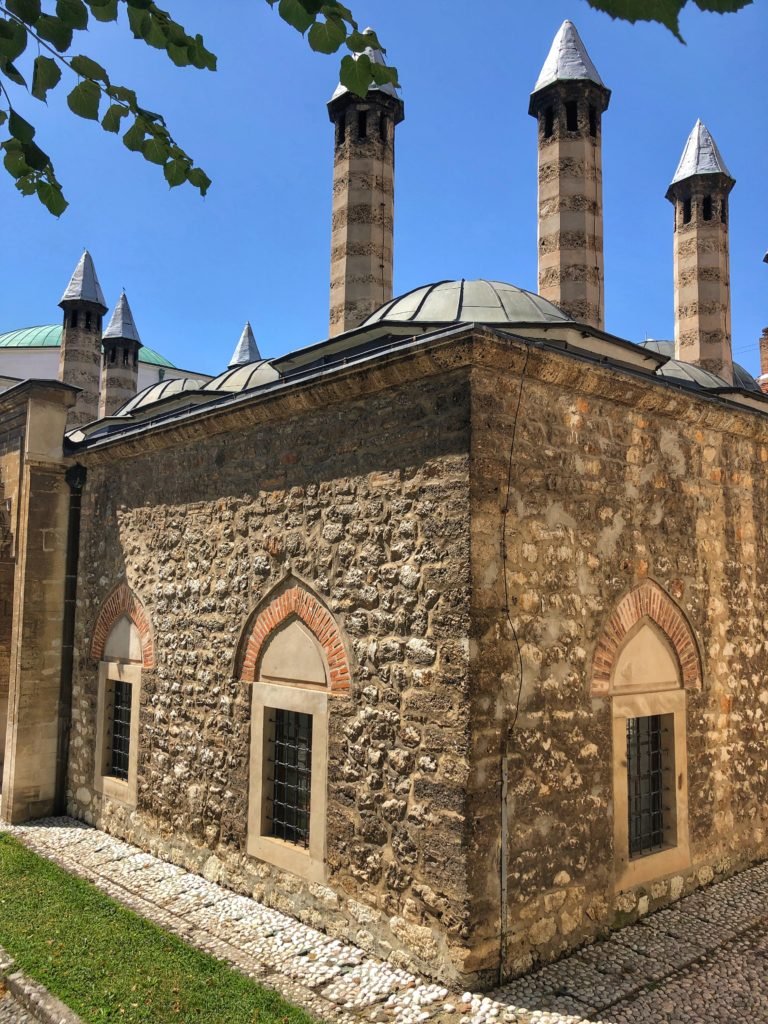
Gazi Husrev-Begova Museum

The Islamic culture has always been known for their cleanliness and good hygiene. Case in point, the oldest public restroom, still functioning, dating from 1530.

Tašlihan was one of three caravanserais in Sarajevo which served both travelers and horses. A caravanserai was actually a large fort-like structure which could accommodate an entire caravan, with all of the pack horses and merchants. Amazing structure!
Bosnia & Herzegovina Wrap-Up
Time Spent: 10 days
Money Spent: $506.69 or $50.69/day
Budget Travel Meter*: $$
The Budget Meter gauges how hard it was for us to stick to our $50/day budget. We’re factoring our Budget Meter by our daily food consumption options.
- $ – Eating-out up to twice a day and ordering whatever the hell we want, with dessert!
- $$—Eating-out once a day in a restaurant of our choice
- $$$—Eating-out once a day, on cheap pizza or local street food meals, usually involving copious amounts of filling bread
- $$$$—Eating-in every meal, healthy/fresh & in-season produce options
- $$$$$—Eating powdered soup & potatoes for every meal.
Things we loved about Bosnia & Herzegovina:
- The feeling of community in Trebinje
- The off-the-beaten path gem of Pocitelj
- Walking the streets of Mostar early in the morning
- The beautiful and clear rivers
- Being transported to the Middle East in Sarajevo’s main bazaar
- Lots of water fountains, gushing pure spring drinking water
Things that could’ve been better:
- We wish we’d had more time in Sarajevo to soak in the feel of the city and for day trips to sites like the Bosnian Pyramids, and the bobsled track.
- The price of public transportation (mainly buses) wasn’t nearly as cheap as we’d hoped/anticipated.
- Less meat, more veggies…for variety and our budget, and to shake off the meat comas.
Would we go back?
Yes, but it wouldn’t be at the top of our list.







